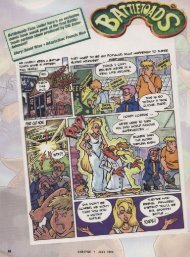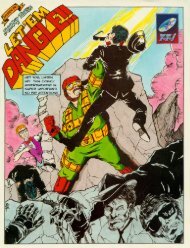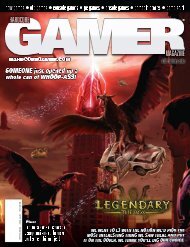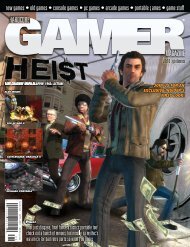Create successful ePaper yourself
Turn your PDF publications into a flip-book with our unique Google optimized e-Paper software.
How does one classify Kururin Squash? Maze game? Maybe, but it’s not like they don’t provide a<br />
map. Puzzle? Not really, it’s got more to do with manual dexterity than solving anything really<br />
tricky. Spinny stick game? Perfect, although it’s not a genre overflowing with competition.<br />
In Kururin Squash, you get to play as a blue chicken piloting a ship that slowly spins like the blades of a<br />
helicopter, navigating through treacherous passages in search of his missing family members. It seems a mad scientist duck has kidnapped<br />
them, and only the powers of advanced maze navigation can bring them home. Add in cut-scenes designed to look like a cardboard puppet<br />
show (complete with sticks coming from the bottom of the screen to animate the arms) and it’s one enjoyably weird little package.<br />
Basically, as stated earlier, Kururin Squash is a candy-colored manual dexterity test. The mazes are bright, colorful, and filled with objects,<br />
and they get brutally hard. While the paths are nice and open to start with, eventually the walls go jaggy and close in tight, often with only a<br />
spare pixel or two between the ship and the wall. The ship is constantly rotating, which makes things harder, but the pinpoint precise analog<br />
control makes even the hairiest corridor possible. Not easy, barring the early levels, but with a bit of practice the maze can be navigated<br />
with style and speed. This is a good thing, seeing as there’s a timer. While only a bonus goal, getting the best time and collecting all the<br />
coins adds a great touch of replay to the game.<br />
In addition to the standard maze navigation, each area has two levels with a specially-enhanced ship.<br />
The river levels have a craft that can submerge for a few seconds, for example, while the snow levels<br />
have one running along a preset track and armed with flamethrowers. These ships are also used to great<br />
effect in the boss fights, which are nicely challenging without being maddening.<br />
The thirty-five levels of the story mode are supplemented by forty-plus time-attack levels. The nofrills<br />
levels are just as devious as the story-based ones, but without any reason to do them beyond the<br />
maddening fun of going for the perfect time. There’s also a GBA link-cable game, but it’s a simple patternmatching<br />
thing that’s amusing for about a minute. It might be more fun in four-player, but I kind of doubt it.<br />
Kururin Squash is simple at heart, but the best games frequently are. It gives the player a task to accomplish<br />
and the perfect controls to do it with, and no matter how evil the going gets it’s never actually unfair. The<br />
addictive gameplay is supplemented nicely by plenty of replay value, and there’s even some customization<br />
available in the form of a shop where new ship skins can be bought. Very few games let a blue chicken<br />
pilot a cow ship with a horn that goes “Mooo!”, but if they’re going to be this good, then maybe<br />
we could use some more.<br />
Publisher: Eighting<br />
Developer: Nintendo<br />
Release Date: 2004<br />
Genre(s): Maze Navigation<br />
Category: Spinny Stick<br />
# of Players: 1-4<br />
Review by James<br />
Kururin Squash is a lot of fun, and with almost no Japanese beyond a few menus it’s a perfect<br />
candidate for <strong>importing</strong>. While the story will be lost, it’s nonsensical enough not to matter much.<br />
It’s an addictive little beastie <strong>worth</strong> the time of anyone who appreciates pick-up-and-play gaming.<br />
A24689<br />
(Kururin Squash)<br />
4.5 of 5<br />
74_JAPAN_KURURIN SQUASH HARDCORE GAMER MAGAZINE_VOLUME 1_ISSUE 9_WARM BUN<br />
Hiding among all the big-name anime<br />
fighters and horizontal/vertical shooters, a<br />
smaller genre tosses out low-budget titles<br />
every now and then in the hopes of getting<br />
a little bit of love. While it’s had its day in<br />
the sun (everyone loves Lolo!) that time is<br />
now long gone, with only games like Frantix<br />
to fill the void. Yes, I’m talking about mazebased<br />
puzzlers here.<br />
The Lost Golem tells the story of a king who’s<br />
gone missing and the golem sent after him<br />
for protection. While probably good enough<br />
at running a country, the king isn’t too skilled<br />
at saving his own skin, so the golem has to do<br />
it for him. Unfortunately the golem can’t just<br />
pick up and lug the king around, so instead<br />
moves the maze walls to create a path to the<br />
exit. Careful planning is required, though,<br />
because the king will happily walk past an open door and into a<br />
pit if guided wrong.<br />
In addition to walls, there are also posts throughout the maze.<br />
These act as two types of wall connectors. The regular ones<br />
just make for a long, unbroken wall while the posts with a ball<br />
on top allow the wall to turn 90 degrees. On top of that, each<br />
maze has one red wall that has to survive until the end of the<br />
level. When the king reaches the exit, the golem consumes the red wall and any other walls attached<br />
to it by the posts. If you have too few walls connected together, the level’s a failure. Proper<br />
management of walls, posts, and the king are all required to survive to the next area.<br />
Lost Golem is a fairly slow-paced game. The king walks forward one space at a time, and once a path<br />
has been figured out it’s easy to set it up well in advance of his arrival. There are a few tricky parts,<br />
like timing a rotating wall to swat the king over a pit, but for the most part the challenge comes<br />
from figuring out what to do rather than racing to get it done.<br />
And while a good test of brainpower, Lost Golem isn’t the prettiest game on the system by a long<br />
shot. Everything is very low-polygon, including the king and golem, and even the cut-scenes are<br />
presented in a slide-show style. There’s also no zoom, rotate or pan controls, although to be fair<br />
they aren’t really needed. All the level information is clearly presented, and very few mazes are<br />
larger than a screen in size. Though the game isn’t really harmed by its visuals, a little graphic polish<br />
wouldn’t have hurt any.<br />
All told, The Lost Golem is an enjoyable little puzzler. The difficulty curve is just right, slowly<br />
introducing new elements at the start while getting amazingly tricky later on, and there’s even room<br />
for improvisation in tackling the challenges. It’s a fun little obscurity, and <strong>worth</strong> tracking down for<br />
the Dreamcast owner looking for something a little more thoughtful than the next arcade shooter.<br />
While a fairly nifty little game, The Lost Golem isn’t really<br />
going to set anyone’s world on fire. It’s got very little<br />
Japanese beyond the cut-scenes, though, so if you’re into<br />
low-budget games with soul then give it a go.<br />
Review by James<br />
Publisher: Caramelpot<br />
Developer: Caramelpot<br />
Release Date: 1998<br />
3 of 5<br />
Genre(s): Maze/Puzzle<br />
Category: Idiot King Guidance<br />
# of Players: 1<br />
HARDCORE GAMER MAGAZINE_VOLUME 1_ISSUE 9_WARM BUN THE LOST GOLEM_JAPAN_75














